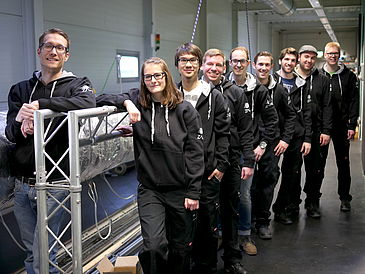You’d never think it just looking at a candle: But when used as fuel, paraffin develops an unexpected power potential. Mixed together with liquid oxygen in a combustion chamber, it forms a fuel combination that releases enough energy and thrust to launch a 3.8-meter rocket weighing 80 kg to an altitude of 4,000 meters at supersonic speed. A group of students at the University of Bremen’s Center of Applied Space Technology and Microgravity (ZARM) wanted to test this hypothesis, spending four years working on a project to prove it.
On March 24, 2016, their self-built hybrid-drive rocket, which could almost be described as environmentally friendly, will travel to the North of Sweden where it is planned to start its journey into space from the Esrange European spaceport in Kiruna on April 12, 2016. In the frame of their research project, the rocket was given the name ZEpHyR, derived from “ZARM Experimental Hybrid Rocket”. This turns out to be a rather fitting name especially for the time of year, since in Greek mythology ZEpHyR means something like “herald of spring” and “wind god”. For the Bremen students in the Faculty of Production Engineering, ZEpHyR’s maiden flight marks the grand finale of their STERN program supported by the German Aerospace Center (DLR). STERN gives German university teams the opportunity to gain practical experience of aerospace research by designing and building their very own rockets.
Aerospace 4.0
The Bremen team designed their own project. They set themselves the task to develop an innovative rocket compatible with the objectives of Aerospace 4.0. This entails taking account of numerous factors like cost efficiency, ease of handling, and minimization of risk to humans and the environment by developing alternative fuel to hydrazine, the highly toxic and explosive propellant normally in rockets. Although it might sound simple, the task called for a creative approach involving knowledge transfer from the areas of combustion research, mechanical engineering, electrical engineering and chemistry, not to mention a good deal of skilled craftsmanship. “We were the only team participating in the STERN program to settle on a combination of paraffin and oxygen as propellant for our rocket. However, other research teams in Europe have also been exploring similar paths, a clear indication that the concept bears potential for future aerospace projects. It’s good to know our expertise is in step with the latest trends”, says Peter Rickmers, who leads and supervises the ZEpHyR project at ZARM.
Research-based learning promotes creativity
The main focus of the research and development in Bremen was on the hybrid drive. This had to be conceived completely from scratch and involved finding the correct mix for the propellant components. It took no fewer than 30 engine test runs before the team hit on the correct mixture ratio of wax and oxygen, one that combined high performance with relatively straightforward system complexity. In order to keep the costs of components as low as possible, the team resorted to programming a 3D printer and produced the thrusters comprising a mixture of cotton and resin themselves. They also made the otherwise expensive valves used to regulate the supply of oxygen. The rocket’s control electronics were purchased from retail stores, and the parachute to bring the rocket safely down to earth again can be found in the outdoor leisure segment. In other words, the rocket components are available to virtually anyone. Hence, the ZEpHyR project also contributes towards making aerospace more accessible to players in the private sector, promoting innovative creative ideas for future space exploration.
Quite apart from just how successful the rocket launch turns out to be, the students in the Bremen team are already in a win-win situation. More than 35 Bachelor and Master dissertations were produced in the frame of the ZEpHyR project – underscoring its potential as a model for university education.
Rocket campaign time schedule:
- March 24, 2016, the ZEpHyR rocket is dispatched to Esrange Space Center in Kiruna, Sweden
- April 3, 2016, ZEpHyR team travels to Kiruna, Sweden
- April 4-11, 2016, preparation for launch
- April 12, 2016, planned date of launch
- April 15, 2016, ZEpHyR team returns to Bremen
Bremen student team contacts for inquiries concerning launch and project
University of Bremen
ZARM – Center for Applied Aerospace Technology and Microgravitation
Dr.-Ing. Peter Rickmers
Head of Space Propulsion and Energy Systems Group
Phone: +49 421 218 57872
Cell +49 172 5122120
email: peter.rickmersprotect me ?!zarm.uni-bremenprotect me ?!.de
Contact for general press inquiries, photos and graphic materials
Birgit Kinkeldey
Leader of Communication
Phone: +49 421 218 57755
Cell +49 151 23684370
email: birgit.kinkeldeyprotect me ?!zarm.uni-bremenprotect me ?!.de

